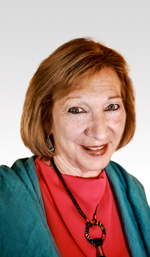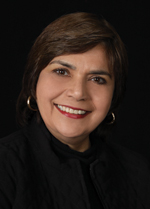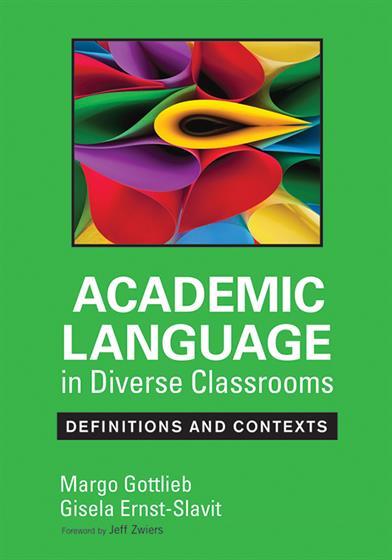
Hands-on, Practical Guidance for Educators
From math,
literacy, equity, multilingual learners, and SEL, to assessment, school counseling,
and education leadership, our books are research-based and authored by experts
on topics most relevant to what educators are facing today.
Academic Language in Diverse Classrooms: Definitions and Contexts
Foreword by Jeff Zwiers
This companion volume to Margo Gottlieb and Gisela Ernst-Slavit’s definitive six-book series on academic language provides a go-to reference of key concepts and effective practices.
- Grade Level: PreK-12
- ISBN: 9781452234786
- Published By: Corwin
- Year: 2014
- Page Count: 256
- Publication date: April 22, 2014
Price: $39.95
For Instructors
When you select 'request review copy', you will be redirected to Sage Publishing (our parent site) to process your request.
Description
With the rigorous content of College and Career Readiness standards, academic language use has moved to the forefront of educational priorities. School leaders and teachers must ensure that academic language becomes the focus of new curricula, instruction, and assessment, with special attention to linguistically and culturally diverse students.
The author’s six-book series on academic language is already the definitive resource on the topic. This companion volume provides a concise, thorough overview of the key research concepts and effective practices that underlie the series. Including:
- Definitions and examples of the dimensions of academic language.
- A step-by-step template to incorporate academic language use into plans for student learning.
- Graphic models that illustrate the construct of academic language and its classroom application.
Language is the most fundamental building block of education. Be sure your school is as strong as it can be with this indispensable book.
"This book brings language learning in the classroom alive! Against a backdrop of new standards, the authors skillfully take the reader through detailed vignettes of classroom practice that support students’ development of academic language, while at the same time discussing why the practice is effective.”
—Margaret Heritage, Assistant Director for Professional Development
National Center for Research on Evaluation, Standards and Student Testing (CRESST) at UCLA
Key features
(2) Includes graphic models that to explain and clarify the construct of academic language
(3) Presents definitions and examples of each of the components of academic language.
(4) Features a step-by-step template for teachers who wish to incorporate academic language into their planning for student learning.
Author(s)

Margo Gottlieb
Margo Gottlieb, Ph.D., is a staunch advocate for multilingual learners and their teachers. As co-founder and lead developer of WIDA at the University of Wisconsin-Madison in 2003, Margo has helped design and contributed to all the editions of WIDA’s English and Spanish language development standards frameworks and their derivative products. Being a bilingual teacher, facilitator, consultant, and mentor across K-20 settings, she has worked with universities, organizations, governments, states, school districts, networks, and schools in co-constructing linguistic and culturally sustainable curriculum and reconceptualizing classroom assessment policy and practice.
Margo’s passion has always been assessment in its many forms, starting with her dissertation, a K-12 multilingual test in Spanish, Lao, and English that integrated content and language. Since then, she was appointed to national and state advisory boards, served as a Fulbright Senior Scholar, and was honored by the TESOL International Association in 2016 for her significant contribution to the field. In her travels, Margo has enjoyed keynoting and presenting across the United States and in 25 countries. Having authored, co-authored, or co-edited over 100 publications, including 20 books and guides, Margo's 3rd edition of her best-selling book, Assessing Multilingual Learners: Bridges to Empowerment, is the latest addition to her Corwin compendium.

Gisela Ernst-Slavit
Table of Contents
Foreword
Preface
Acknowledgements
About the Authors
In the Beginning….
1. What is Academic Language?
The Role of Language in Schooling and Beyond
Different Registers
The Nature of Academic Language
Evolving Perspectives of Academic Language
Academic Language Versus Social Language Perspectives
Systemic Functional Linguistic Perspectives
Language Skills Perspectives
Sociocultural Perspectives
Language as Action Perspectives
Academic Language Learning as a Developmental Process
Considerations for Students with Disabilities
Oral and Written Languages
Oral Language as a Vehicle for Promoting Academic Language Development
Oral Language as a Bridge to Literacy
Multiliteracies and Multimodalities as Sources of Academic Language
Raising Awareness of Academic Language
Academic Language and Social Justice
For Further Thinking
2. What Are the Dimensions of Academic Language?
Identifying Academic Language Within and Across Content Areas
Analyzing Academic Language Within Discourse
Balance Between Informational and Literary Texts
Differences Between Nonfiction and Informational Texts
Examining Sentence-Level Structures
Language Functions as Expressions of Sentence-Level Meaning
Identifying Vocabulary--Words, Phrases, and Expressions
Development of Academic Vocabulary
Teaching Academic Vocabulary in Authentic Contexts Through Meaningful Interactions
Vocabulary Instruction for English Language Learners
For Further Thinking
3. How Do Standards Define and Shape Academic Language Use?
The Impact of the New Standards on Shaping Academic Language
Bringing Standards Together: Content Learning Through Language and Language Learning Through Content
Content and Language Learning for English Language Learners
The Impact of Standards in Shaping Grade-Level Language for Academic Purposes
Academic Language Within Content Standards
Resources for ELLs for the New Content Standards
Examples of Academic Language in Content Standards
Academic Language in English Language Development/Proficiency Standards
Academic Language Use in Language Standards
The Impact of Home Language on Academic Language Development
Suggestions for Redefining Teaching and Learning Around Academic Language Use
For Further Thinking
4. How is Academic Language Used in Content Areas Schoolwide?
Seeing Academic Language Throughout the School Day
Listening in the Music Classroom
Moving From a Physical Education Class to the Arts
Looking Into Mathematics Classrooms
Entering an English Language Arts Class
Visiting a Science Class
The Language of Science Textbooks
Exploring Academic Language in a Social Studies Class
The Specialized Language of Social Studies Texts
Effective Instruction in Content Classrooms Around a Unit of Learning
For Further Thinking
5. How Can Academic Language Be Integrated Into Instruction and Assessment?
Maintaining a Focus on Academic Language: A Historical Perspective
Planning a Unit of Learning Around Academic Language Use
Capitalizing on Linguistic and Cultural Resources
Deciding on a Theme for a Unit of Learning
Matching the Theme to Standards
Academic Language Use in Learning Targets and Differentiated Objectives
Infusing Academic Language Into Unit Targets and Differentiated Lesson Objectives
Instructional Activities and Tasks
The Relationship Between Assessment and Instruction
Placement of Assessment Within a Curricular Framework
Assessment Across Lessons of a Unit: Measuring Standards and Learning Targets
Assessment Within Lessons: Measuring Differentiated Objectives
Crafting Instructional Activities and Tasks
Reflecting on Teaching and Learning
Teacher Reflection
Student Reflection
For Further Thinking
6. How is Academic Language Situated in Curricular Design and Infused Into Professional Learning?
A Theoretical Basis for Curricular Frameworks
Early Thinking on Curriculum
Recent Thinking on Curriculum
Conceptual Frameworks That Integrate Language and Content
The Value of an Integrated Curricular Framework for Diverse Schools and Districts
A Curricular Framework That Features Academic Language Use
The Role of Professional Learning in Understanding and Promoting Academic Language Use
Implementing Professional Learning: From Two Participants to District Level Participation
Making School a Meaningful Experience for 21st Century Students
Culturally and Linguistically Responsive Teaching and Learning
Transformation of Schools
Promoting Academic Language for All Students and Teachers
Seeking Advocacy Within the Educational Community
For Further Thinking
At the End….
Resources
A. CCSS for Mathematics and Related Academic Language
B. Examples from the CCSS for English Language Arts of Related Academic Language
C. A Curricular Framework Highlighting Academic Language
Glossary
References
Index
Reviews
"This book brings language learning in the classroom alive! While there is plenty of theory and research to ground the practices the authors describe, this is not a dry book about language learning. Against a backdrop of new standards, the authors skillfully take the reader through detailed vignettes of classroom practice that support students’ development of academic language, while at the same time discussing why the practice is effective. For those who are interested in learning more about academic language and how to help students develop it, this book is a must read."
Margaret Heritage, Assistant Director for Professional Development"This book brings language learning in the classroom alive! While there is plenty of theory and research to ground the practices the authors describe, this is not a dry book about language learning. Against a backdrop of new standards, the authors skillfully take the reader through detailed vignettes of classroom practice that support students’ development of academic language, while at the same time discussing why the practice is effective. For those who are interested in learning more about academic language and how to help students develop it, this book is a must read."
National Center for Research on Evaluation, Standards and Student Testing (CRESST) at UCLA
"This detailed and richly exampled book provides a comprehensive framework for both pre-service and practicing teachers to dig deeply into the nature and development of the language skills necessary for academic success. It emphasizes the need to move beyond a narrow conception of academic language as vocabulary words to an exploration of the nature of instructional and assessment practices that develop language and thinking at the conceptual and discourse levels. The classroom-based examples from across the curriculum, including the arts and physical education, illuminate the nature of the language demands unique to and common across each discipline. I highly recommend this book as a vital tool to guide curriculum planning and renewal at every level."Nancy Commins, Clinical Professor
School of Education and Human Development, University of Colorado at Denver
"Academic Language weaves content and language teaching as a focus for designing viable units of learning throughout the school year. By providing students with linguistic tools to understand and use academic content, it enhances their opportunities to meet the rigor of the Common Core State Standards and the Next Generation Science Standards. The authors offer explicit examples of how to build students’ language development using a framework with clear learning targets that lead to effective teaching practices."
Janeen A. Kelly, Director of Department of ELL/WL"Academic Language weaves content and language teaching as a focus for designing viable units of learning throughout the school year. By providing students with linguistic tools to understand and use academic content, it enhances their opportunities to meet the rigor of the Common Core State Standards and the Next Generation Science Standards. The authors offer explicit examples of how to build students’ language development using a framework with clear learning targets that lead to effective teaching practices."
Washoe County School District, Reno, NV
"This book provides a promising vision on how to teach academic language to diverse learners including English Language Learners (ELLs). The authors present a comprehensive framework that combines learning content and language in ways that engage students to learn key ideas and concepts, link concrete knowledge and abstract knowledge, and promote critical thinking. The specific steps on how to create differentiate language objectives for ELLs at different levels of English language proficiency is particularly helpful. I highly recommend this book for general education and English as-a-second language teachers who work as a team to provide effective instruction for diverse learners."
Maria del Rosario (Charo) Basterra, Deputy Director"This book provides a promising vision on how to teach academic language to diverse learners including English Language Learners (ELLs). The authors present a comprehensive framework that combines learning content and language in ways that engage students to learn key ideas and concepts, link concrete knowledge and abstract knowledge, and promote critical thinking. The specific steps on how to create differentiate language objectives for ELLs at different levels of English language proficiency is particularly helpful. I highly recommend this book for general education and English as-a-second language teachers who work as a team to provide effective instruction for diverse learners."
The Mid-Atlantic Equity Center
For Instructors
When you select 'request review copy', you will be redirected to Sage Publishing (our parent site) to process your request.

